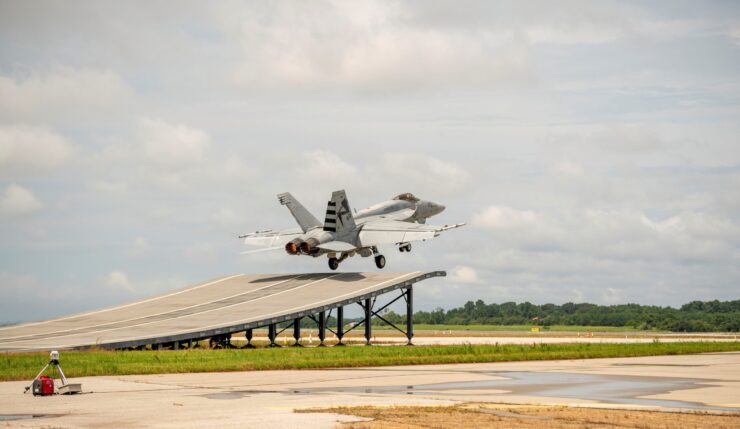The role of naval aviation in defending India’s maritime interests is expected to get significantly enhanced as a result of the current geo-political situation that India is facing. The formation of the QUAD and AUKUS signifies that partnership between ‘like-minded’ countries on the Indo-Pacific will only grow stronger. The strength of the partnership for Indo-Pacific will be determined by the abilities of the countries to work together seamlessly. Commonality and interoperability of defence assets contributes not only towards efficient operations of the partner countries but also offer significant enduring strategic benefits to the partners. The Boeing F/A-18 Super Hornet Block III for the Indian Navy will offer several such strategic advantages to India.
The F/A-18 Super Hornet serves as the frontline multi-role fighter of the US Navy. More than 800 Super Hornets and Growlers (electronic attack variant based on the Super Hornet platform) are in the global fleet. The Block III is the most advanced Super Hornet ever built and Boeing is delivering operational capable Block IIIs to the US Navy. The Block III configuration is suited to protect India’s maritime interests as it’s built to meet the broadest range of missions while benefiting from the upgrades and knowledge related to US naval aviation. We anticipate the Super Hornet opening up opportunities for greater interoperability between the two navies for a secure Indo-Pacific.
In the coming years, the Indian Navy will have two fully functioning aircraft carriers – INS Vikramaditya and the new indigenous aircraft carrier INS Vikrant (IAC-1). Even though these carriers were designed for Russian and indigenous aircraft, Boeing has conducted several studies over the last couple of years that demonstrate that the F/A-18 Super Hornet will be fully compatible with both these carriers. Super Hornets are purpose built for life on a carrier and come with a folded wing feature that allows the aircraft to fit within the relatively smaller confines of the Vikramaditya and IAC-1 carrier lifts. Since there is no need to remove the aircraft structure for carrier fitment, the F/A-18 Super Hornet’s carrier fit solution is safe and proven.
In September 2020, Boeing successfully conducted ski-jump tests and extensive simulation studies that prove that the F/A-18 can operate from Indian Navy aircraft carriers and will meet or exceed their STOBAR performance requirements.
The F/A-18 Super Hornet Block III incorporates several new technology upgrades. Key among those are new adjunct processor, increased airframe life to 10,000 hours, radar cross-section improvements and the advanced cockpit system with a 10×19-inch touch screen display.
Block III’s networking allows F/A-18 Super Hornet to interface with other assets of the Indian Navy. For example, F/A-18s of the Indian Navy can potentially share data with P-8Is of the Indian Navy or P-8 of US Navy and Royal Australian Air Force to significantly improve the capability of the partner countries for securing the Indo-Pacific.

The F/A-18 Super Hornet for the Indian Navy will come in single and two-seater configuration, both of which are carrier-compatible. Recently, there has been tremendous advancements in unmanned systems that are to be used in a naval aviation environment. In the coming days, as Indian Navy inducts such systems, a two-seater Super Hornet on the Indian Navy carrier will allow interfacing with unmanned carrier-borne systems more effectively.
Additionally, two-seater F/A-18 Super Hornets can be used as trainers (ashore and on the carrier) and as fully capable fighters, operational from carrier and from land bases. Thus, Indian Navy will get tremendous flexibility and high asset utilization rate due to the carrier compatible variant of the two-seater variant of the F/A-18.
The large operating fleet of the Super Hornets in service creates scale efficiencies and offers attractive operating costs. Boeing has developed a unique sustainment program for the F/A-18 Super Hornet for Indian Navy called ‘By India-For India’. This program aims to develop select capabilities in the Indian supplier base to maximize localization of lifecycle sustainment. The engine family synergy between F/A-18 Super Hornet and the indigenous fighter Light Combat Aircraft Tejas (GE F 414 and GE F 404 respectively) is also expected to create scale efficiencies for potential sustainment opportunities in India in the future.
The F/A-18 Super Hornet’s offer is a perfect confluence of several strategic benefits for the Indian Navy. Through the Super Hornet, the Indian Navy will not only get the most advanced naval fighter but will further the collaboration between US Navy and Indian Navy in naval aviation. The commonality and potential interoperability between the navies of partner countries in the Indo-Pacific will get a boost as a result of the F/A-18 Super Hornet on Indian naval carriers.
The writer is Vice President, India Fighters Lead, Strike, Surveillance & Mobility – Boeing Defense, Space & Security













